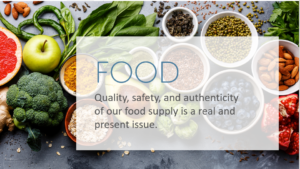Smaller and more sensitive Raman instruments are facilitating new solutions for food analysis, providing rapid, on-site authentication and quality testing throughout the food chain. In this Photonics Spectra article, Raman Spectroscopy Dishes up Solutions for the Food Industry, our own Cicely Rathmell explores some of the common questions about analysis of foods using Raman spectroscopy: What instrumentation is available and which excitation wavelength should be used? How should the spectra be interpreted or analyzed? And perhaps most importantly, what kinds of problems can be addressed with Raman?
Raman spectroscopy is emerging as a powerful new analytical technique for food analysis, and it’s just getting started. The demand for food testing is growing, and research groups are expanding the types of related questions that Raman can answer. Smaller and more sensitive Raman spectrometers such as those manufactured here at Wasatch Photonics are poised to enable rapid, on-site authentication and quality testing throughout the food chain.  Established testing and authenticating techniques like chromatography, nuclear magnetic resonance, stable isotope analysis, spectroscopy, and DNA-based methods require expensive instrumentation, skilled operators, time-sensitive analysis, and consume a portion of the sample. With Raman spectroscopy, the need to validate the quality, authenticity, purity, and provenance, as well as the safety of food products, can be done in the field. Raman spectroscopy allows food analysis to be performed rapidly, without consuming any of the sample, and even through glass or plastic packaging.
Established testing and authenticating techniques like chromatography, nuclear magnetic resonance, stable isotope analysis, spectroscopy, and DNA-based methods require expensive instrumentation, skilled operators, time-sensitive analysis, and consume a portion of the sample. With Raman spectroscopy, the need to validate the quality, authenticity, purity, and provenance, as well as the safety of food products, can be done in the field. Raman spectroscopy allows food analysis to be performed rapidly, without consuming any of the sample, and even through glass or plastic packaging.
When it comes to food analysis with Raman, accurate answers depend upon acquiring spectra with a good signal-to-noise ratio (SNR) and a high degree of reproducibility. This is because the spectral differences needed to distinguish between two similar food samples can be small and may emerge only from the chemometrics. The ideal Raman instrument for field-deployable food analysis captures the maximum signal in the minimum time, with a high degree of reproducibility, to yield a high SNR and consistent spectra. At Wasatch Photonics, we deliver with the sensitivity and reproducibility you need, as well as the software and direct data access needed to translate those spectra into solutions. Learn more about our benefits
Advancements in Raman instrumentation are progressing quickly, making it faster, more cost-effective, and portable than ever. When combined with the expanding chemometrics options for data analysis, these instrumentation advancements position Raman technology for tremendous growth. Learn more about our expertise in this area in the article we wrote for Photonics Media, Raman Spectroscopy Dishes Up Solutions for the Food Industry. It details what to look for in selecting the right Raman spectrometer for food analysis, provides insights from companies already using Raman spectrometers in food testing and authentication, and the types of information that can be detected using Raman throughout the food chain.
Read the article in Photonics Media – Raman Spectroscopy Dishes Up Solutions for the Food Industry
Learn more about the Raman Wavelengths Most Widely Used for Food Analysis – 785 and 1064 nm:
- WP 785X Raman Spectrometer
- WP 1064X Raman Spectrometer
- User-reconfigurable Raman probe
- ENLIGHTEN™ operating software
May 16, 2021


